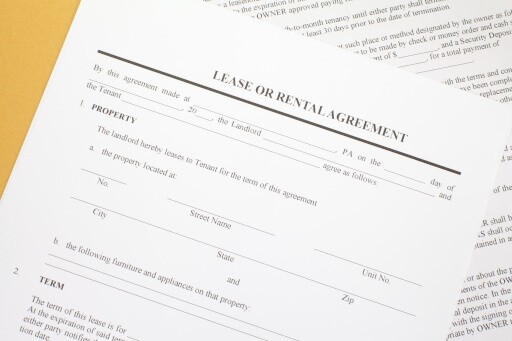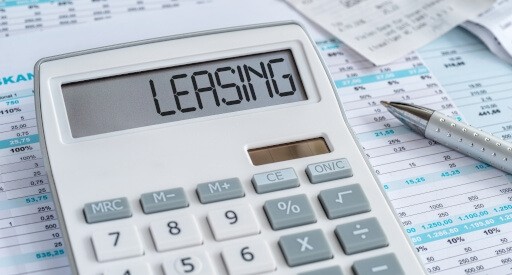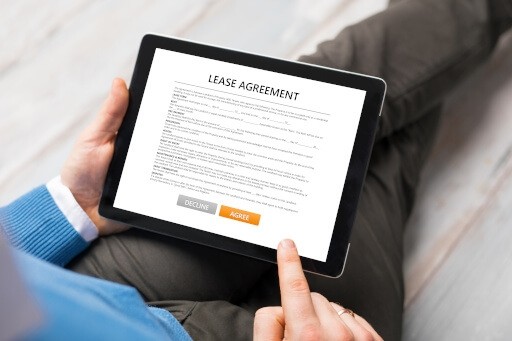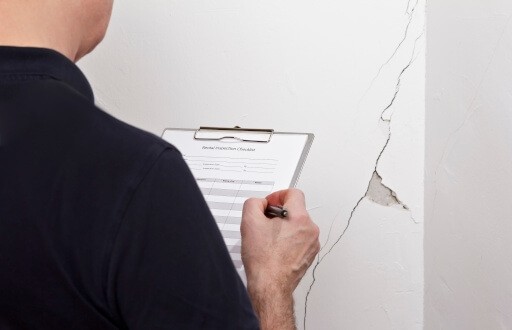
Signing a lease is a pivotal step for both landlords and renters. Once all is signed on the dotted line, both parties will be contractually bound for the duration of their rental lease term.
Given their significance and legal parameters, lease agreements might seem daunting for a first-time landlord. However, the lease signing process is actually fairly simple and, when done correctly, can be a breeze for all parties involved.
In this article, we’ll break down the lease-signing process to better your understanding of how it works and what to expect by answering the following questions:
- What are the steps of the lease signing process?
- What happens if a tenant breaks their lease?
- How does a landlord terminate a lease early?
What Are the Steps of the Lease Signing Process?
The lease signing process has three steps. First, the landlord creates the lease and sends it to the renter. Then, the renter reviews the lease, signs it, and returns it to the landlord. The landlord then reviews the agreement once more and provides a final signature.
Below, we’ll examine each of these steps in depth and discuss what landlords should keep in mind throughout the lease-signing process.
Step One: Creating the Lease
The first step in the lease signing process is creating a lease agreement. When done correctly, this step sets you up for success throughout the rest of the lease-signing process. However, the lease creation process can be complex and requires careful attention to detail. The goal is to be as thorough as possible and leave your prospective renter with no unanswered questions.
To create a lease that effectively outlines all terms and conditions for your renter, complete the following steps:
- Research your state laws- Every state has specific landlord-tenant regulations that must be followed when creating a lease agreement. Research and understand these laws before drafting your lease agreement.
- Include all necessary information – Your lease agreement should include your and your renter's contact information and addresses. It should also have important details about the rental property, such as property type, address, damages or defects, included fixtures, appliances, or furniture, and condo/homeowner’s association information, if applicable.
- Determine the lease term – In your lease agreement, you’ll identify the lease as either a short-term or a long-term lease. Short-term leases are either month-to-month or three-to-six-month and are a good option for temporary stays. Long-term leases extend from six to fifteen months, with the standard duration being twelve months. Outlining lease length is important because it impacts other elements of your contract, such as the rent price or utilities. Before you can outline specific details, such as the tenant’s monthly payments, you must finalize your tenant’s lease term.
- Set a monthly rent price and due date – Once you finalize the lease term, determine your unit’s rent price. Rental unit prices fluctuate depending on the lease length and the time of year. While landlords usually price long-term rentals competitively, they often charge higher rates for short-term rental properties. Likewise, landlords may charge tenants higher rates when demand increases in the summer and lower rates when demand falls in the winter. To determine the rent price for your lease agreement, consider the lease term and the current demand. Then, establish a due date for the first month’s rent and a recurring date for monthly payments.
- Consider your rules – The lease agreement is your opportunity to lay down the law of the land. Consider what matters most for your rental property. Will your property need recurring maintenance? Are pets a risk to your rental’s condition? Will tenants need to follow quiet hours to maintain a harmonious living environment? These are the questions you should ask when setting your lease terms and conditions. Then, you can set pet policies, renter’s insurance requirements, rental inspection timelines, and more based on your and your property’s needs.
- Address lease violations – Be sure to clearly define the consequences of lease violations, such as late payments or property damage in your rental agreement. Plan for contingencies and discuss what steps will be taken if a renter violates any lease terms. Inserting these clauses will help protect your property and inform your tenant of their obligations.
- Include addendums if needed - If you have any additional rules or conditions specific to your rental property, consider including them in an addendum to the lease agreement. This allows for more flexibility in case of changes or unique situations.
- Get a second set of eyes - Once your lease is drafted, it’s always a good idea to have someone else review it before sending it to your tenant. This will help catch any mistakes or areas that need clarification before sending it off. You might also consider having it reviewed by a lawyer to ensure its legality and protection of both parties.
Step one of the lease signing process is the most important because it lays the foundation for a stress-free lease term and a solid tenant-landlord relationship. With the lease as their guide, tenants know precisely how to care for the property and what to do if an issue arises. Similarly, leases protect landlords legally if a tenant breaches their contract.
Step Two: Sending the Lease for Tenant Review
The second step of the lease signing process is to send the lease for tenant review. Ideally, your renter receives the lease, reads it, and signs on the dotted line. However, some prospective renters may attempt to negotiate lease terms before signing.
For example, if you implement a strict no-pet policy, your tenant may ask to negotiate. If you agree, the tenant will ask that you update the document with the revised terms. Once updated, the tenant will review the lease once more and sign it. It is important to remain open to changes during the review process to finalize a lease that satisfies all parties involved.
Once you reach an agreement, the tenant must sign the lease document first. By signing first, the tenant contractually binds themself to your property and cannot reverse their decision. As a landlord, you should never sign a lease agreement before your tenant. Say you signed the lease, and then your renter stopped communicating or responding to you altogether. This could put you in a sticky situation where you cannot elect another tenant because you’ve already contractually bound yourself to another, regardless of their unresponsiveness.
It is always best practice for the tenant to sign first to avoid unforeseen circumstances. Once the tenant signs the lease, the landlord will then review the document and provide the final signature.
Step Three: Finalizing the Landlord’s Signature
The last step of the lease-signing process is to provide a final signature. This is the final action before the lease becomes legally binding, and your renter can move into your property.
Before signing, make sure to review the lease agreement one more time. This will be especially important if you agree to negotiate certain lease terms. Double-check that all the information on the lease is accurate, such as rent price, lease term, tenant responsibilities, termination policies, etc. Then, confirm that all tenants have signed and dated the lease correctly.
Once you sign the lease, keep a copy of the agreement for your records and provide one to your tenants as well. Then, you can breathe a long sigh of relief and congratulate yourself for completing the lease signing process. Now it’s time for your tenant to move in and begin a new chapter!
What Happens if a Tenant Breaks Their Lease?
Even though lease agreements are legally binding, there’s always a chance that your tenant breaks their lease early. In this case, you might be left wondering what happens next. The answer will depend on your lease agreement’s specific terms and conditions, as well as your state laws.
In the case your tenant prematurely breaks their lease, consider the following courses of action:
- Collect early termination fees - If your tenant breaks their lease without just cause, you may be able to collect an early termination fee. This amount is usually specified in the lease agreement and is meant to cover any costs or inconvenience the landlord incurs due to the unexpected vacancy.
- Release a portion of their security deposit - In most states, landlords are entitled to deduct from a tenant’s security deposit if they breach their lease. However, it's important to carefully document any damages or expenses before returning any portion of the security deposit.
- Find a new tenant - Landlords can choose to try and find a new tenant for their property to mitigate any financial losses. Keep in mind, however, that state laws may limit your ability to charge rent from two tenants at once.
As a landlord, your main concern about a premature lease break is probably your rental income. If your tenant leaves on month eight of a twelve-month lease, are they responsible for paying the remaining four months of rent? In most cases, yes, the tenant will still be liable until you find a new tenant. However, this will depend on your state laws and local ordinances.
How Does a Landlord Terminate a Lease Early?
Terminating a lease early is a hard decision to make. However, it can be necessary if your tenant is not compliant. For example, if your renter violates their lease agreement by not paying rent on time, hosting unapproved guests or pets, damaging the unit, or engaging in illegal or criminal activity, you’re justified in terminating the lease. This is called terminating a lease with cause.
To terminate a lease with cause, you’ll need to follow your state guidelines. Typically, your first step will be to send your renter a letter stating they have a certain number of days to fix the situation. If the renter doesn’t fix the issue within those days, you have grounds to evict them. Always check with your state laws before attempting to evict a tenant, as there may be specific steps and procedures you must follow.
In some cases, landlords may need to terminate a lease without cause. For example, if the landlord decides to sell the rental property or repurpose it for personal use. This is called terminating a lease without cause.
To terminate a lease without cause, landlords typically must give their tenants an official notice well in advance. In most states, the minimum notice period is 30 days. However, there may be exceptions based on specific circumstances or state regulations. Make sure to highlight this clause in your lease agreement during the signing process. Your tenants should be aware of the possibility of early termination before signing on the dotted line.
Create a Lease Agreement with Apartments.com
Signing a lease may seem complicated, but the process doesn’t have to be. With Apartments.com’s suite of Renter Tools, you can easily create a lease that meets both you and your renter’s standards. Our fully customizable lease agreements are state-specific and legally binding, guaranteeing compliance with your state laws and local ordinances.
Once you’ve drafted your lease, you can download it and send it to tenants. The renter can then insert their online signature. If edits need to be made to the lease before signing, the tenant can return it to you as an editable draft. Then, after both parties sign the new lease agreement, Apartments.com will keep all copies for your records.
Frequently Asked Questions
What factors should I consider before signing a lease?
Before signing a lease, consider the lease agreement type, the rent price, and your rules for the tenant. Also, properly screen your tenant before signing a lease to ensure the best candidate leases your property.
Does the tenant always sign the lease first?
A tenant should always sign the lease first. Afterward, the landlord may give the document final approval before it becomes legally binding.
Can a tenant back out after signing a lease?
After signing a lease, a tenant cannot back out without facing potential legal consequences. However, if both parties agree to terminate the lease before the agreed-upon date, they may sign a mutual termination agreement.
Is a verbal lease a legally enforceable agreement?
While a verbal lease agreement is legally enforceable, it is more difficult to prove in court. The best rule of thumb is to keep written copies of your lease agreement, payments, and other relevant documents. A tangible lease agreement may help you defend your case in legal proceedings more than the testament of your word.
How long do you have to sign a lease once it is approved?
Once a lease is approved, both parties must sign the document within a reasonable time frame. This can vary depending on state laws and individual circumstances. It is best to discuss this with your tenant beforehand and agree on a timeline.
Can a landlord change the lease after it is signed?
A landlord cannot change the lease after it is signed unless both parties agree to make changes and sign a new agreement. Both parties must review and discuss any changes before they are made official. Remember to always keep copies of previous versions of the lease for your records.
This article was originally published on June 14, 2022, by Chanahra Fletcher.











